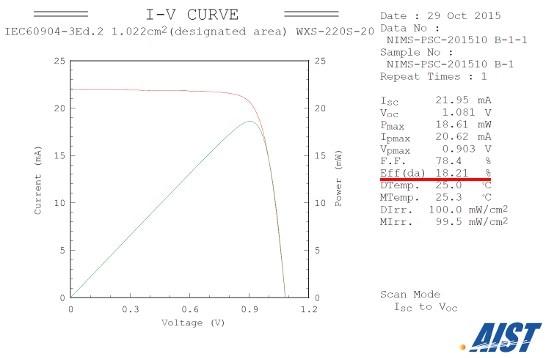Jul 15 2016
A research group led by Liyuan Han, a leader of the Photovoltaic Materials Group, National Institute for Materials Science (NIMS), achieved energy conversion efficiency exceeding 18% using standard size (1 cm2) perovskite solar cells for the first time in the world.
 Current-voltage characteristics of perovskite solar cells measured by the Calibration, Standards and Measurement Team at the AIST Research Center for Photovoltaics. The underlined measurement in red represents a conversion efficiency of 18.2% achieved using the newly developed perovskite solar cells.(Credit: National Institute for Materials Science (NIMS))
Current-voltage characteristics of perovskite solar cells measured by the Calibration, Standards and Measurement Team at the AIST Research Center for Photovoltaics. The underlined measurement in red represents a conversion efficiency of 18.2% achieved using the newly developed perovskite solar cells.(Credit: National Institute for Materials Science (NIMS))
This measurement was made by the Calibration, Standards and Measurement Team at the Research Center for Photovoltaics, National Institute of Advanced Industrial Science and Technology (AIST)--an internationally recognized independent organization for solar cell evaluation.
In most previous reports on conversion efficiencies of perovskite solar cells, measurements were made using small cells (approx. 0.1 cm2). However, these cells are prone to large measurement errors. In addition, these studies did not disclose methods used to measure conversion efficiencies. To promote reliable research and development of solar cells, it is vital that conversion efficiencies are measured using a standard cell size (1 cm2) and by an independent solar cell evaluation organization. In May 2015, NIMS achieved a conversion efficiency of 15% using 1×1 cm cells for the first time in the world. We also proposed a method to produce high-purity, mixed-cation perovskite materials, aiming to further increase conversion efficiency.
Building upon these activities, research group successfully developed high-quality crystal particles that constitute a perovskite layer by adjusting the ratio of different cations in the layer and by substituting some of the iodine with bromine. Consequently, they were able to efficiently extract electrons and holes formed by exposure to light, and succeeded in increasing the short-circuit current density to more than 21 mA/cm2. Furthermore, they accurately controlled the thickness of layers in solar cells such as perovskite and electron transport layers and thereby reduced electrical resistance within the solar cells. As a result, we substantially increased the conversion efficiency to 18.2%.
In future studies, research group plan to develop carrier transport materials with enhanced performance and perovskite materials capable of utilizing a wider range of solar wavelengths. They also aim to continue increasing the cell conversion efficiency to exceed the efficiency of polycrystalline silicon solar cells (approx. 20%)--the most common commercially-available solar cells today in terms of amount manufactured--by controlling interfaces in perovskite solar cells.
A part of these results was produced by implementing the project “Development of technology to reduce the cost of high-performance and high-reliability solar power generation,” funded by the New Energy and Industrial Technology Development Organization (NEDO).